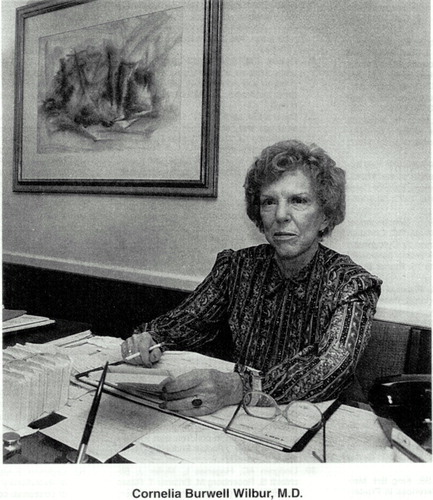Images In Psychiatry: Cornelia Burwell Wilbur, M.D.
Born in 1908 in Cleveland, Ohio, Cornelia Burwell was persistently reminded that she was like her chemist father; she was encouraged to question constantly as she excelled academically to attain the best and highest education to remain self-sufficient. Graduated from the University of Michigan in 1930, she was one of eight women medical college graduates in 1939. The first female medical student extern at Kalamazoo State Hospital, she treated an agoraphobic “hysterical” girl who recovered: “I learned that one should treat the ‘hysteria,’ and not the symptoms.” Thereafter, Dr. Wilbur received Christmas cards from her former patient for 42 years.
Dr. Wilbur trained in psychiatry at Michigan and worked with neuropsychiatrist A.E. Bennett at the University of Nebraska, where she met Sybil, the first patient with multiple personality to be in analysis. In 1949, she moved to New York to complete analytic training to assist her in understanding “hysterics.” Sybil followed, enrolled at Columbia University, and entered into analysis with Dr. Wilbur, during which she told about blackouts and time loss and, during one session, dissociated to the personality Peggy. Dr. Wilbur considered her most important American Academy of Psychoanalysis presentation to be “Transference in Multiple Personalities” (1959). It was published in Dissociation in March 1988. Dr. Wilbur asked Science Digest editor and City College English professor Flora Schreiber to write the story of Sybil.
In 1967, Dr. Wilbur was invited to join the University of Kentucky faculty, served as acting chair, and retired at the age of 65 as professor emerita. She lectured in academic centers, to the public, and to local and national legislators about generations of child, spouse, and elder abuse, all its forms, repercussions, and needed laws. Her other interests included increasing admissions of women to medical school, the women’s and men’s movements, identification of multiple personality in prisoners, parenting education for abuse prevention, and self-fulfillment. She believed that “life is for the living” and “you can change your life.” She founded a shelter for multiple personality patients in Lexington, Ky., and fostered the team approach, including the clergy, to patient treatment.
Self-defined as eclectic, Dr. Wilbur wrote about learning theory and all the more current forms of psychotherapy. She praised Sigmund Freud for beginning the understanding of a continuum of psychotherapy. Dr. Cornelia Burwell Wilbur—pioneer clinician, researcher, educator, and mentor, 18th signer of the American College of Psychiatrists" Charter—died at 83 in 1992, beloved by countless women and men trainees in all fields she encountered and by patients who benefited from her creative wisdom and caring.
Address reprint requests to Dr. Dickstein, Office for Faculty and Student Advocacy, University of Louisville School of Medicine, Abell Administration Center, Suite 202, Louisville, KY 40292. Photograph courtesy of the Lexington Herald-Leader, Lexington, Ky.




